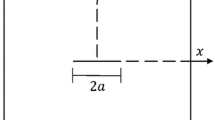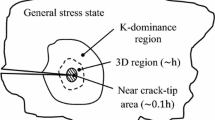Abstract
Experimental approaches to the evaluation of stress intensity factor (SIF) of through-cracked plate components are currently based on the classical plane stress (2D) asymptotic power series expansion of strains or displacements near the crack tip (Williams’ solution). Besides the plasticity effects, the quantitative evaluation of SIF has to take into account a finite domain of convergence of the series expansion as well as three-dimensional (3D) effects, which prevail in the close vicinity of the crack tip. In this paper we demonstrate and confirm that attempts to fit Williams’ solution to experimental data in the near crack tip region can provide misleading results. In addition, it is verified that the SIF can be linked to the transverse displacements in the region controlled by 3D effects, and in particular, by 3D corner singularity. Under mode I loading, the transverse displacement field in this region is uniform, and largely unaffected by the higher order terms of the asymptotic power series expansion, which make this way of the evaluation of SIF particularly attractive for experimental measurements.








Similar content being viewed by others
References
Rooke DP, Cartwright DJ (1976) Compendium of stress intensity factors. Her Majesty’s Stationery Office, London
Tada H, Paris PC, Irwin GR (1985) The stress analysis of cracks handbook. Paris Productions, St. Louis, Mo
Murakami Y (1987) Stress intensity factors handbook. Pergamon Press, New York
Lim I, Johnston IW, Choi SK (1992) On stress intensity factor computation from the quarter-point element displacements. Commun Appl Numer Methods 8:291–300
Courtin S, Gardin C, Bezine G, Hamouda HBH (2005) Advantages of the J-integral approach for calculating stress intensity factors when using the commercial finite element software ABAQUS. Eng Fract Mech 72:2174–2185
Pak YE, Kim S (2010) On the use of path-independent integrals in calculating mixed-mode stress intensity factors for elastic and thermoelastic cases. J Therm Stresses 33:661–673
Theocaris PS (1984) Experimental methods for determining stress intensity factors. Int J Fract Mech 1:707–728
Wei J, Zhao JH (1997) A two-strain-gage technique for determining mode I stress-intensity factor. Theor Appl Fract Mech 28:135–140
Dorogoy A, Rittel D (2008) Optimum location of a three strain gauge rosette for measuring mixed mode stress intensity factors. Eng Fract Mech 75:4127–4139
Humbert L, Valle V, Cottron M (2000) Experimental determination and empirical representation of out-of-plane displacements in a cracked elastic plate loaded in mode I. Int J Solids Struct 37:5493–5504
Ravi-Chandar K (2008) Fracture mechanics. In: Sharpe WN (ed) Springer handbook of experimental solid mechanics. Springer Science + Business Media, New York, pp 125–158
Baik MC, Choi SH, Hawong JS, Kwon JD (1995) Determination of stress-intensity factors by the method of caustics in anisotropic materials. Exp Mech 35:137–143
Yazdanmehr A, Soltani N (2014) Evaluation of stress intensity factors of rounded V and U notches under mixed mode loading, using the experimental method of caustics. Theor Appl Fract Mech 74:79–85
Ayatollahi MR, Nejati M (2011) Experimental evaluation of stress field around the sharp notches using photoelasticity. Mater Des 32:561–569
Sutton MA, Yan JH, Tiwari V, Schreier HW, Orteu JJ (2008) The effect of out-of-plane motion on 2D and 3D digital image correlation measurements. Opt Lasers Eng 46:746–757
Sutton MA, Orteu JJ, Schreier HW (2009) Image correlation for shape, motion and deformation measurements. Springer, New York
McCormick N, Lord J (2010) Digital image correlation. Mater Today 13:52–54
Brynk T, Laptiev A, Tolochyn O, Pakiela Z (2012) The method of fracture toughness measurements of high speed camera and DIC. Comput Mater Sci 64:221–224
McNeill SR, Peters WH, Sutton MA (1987) Estimation of stress intensity factor by digital image correlation. Eng Fract Mech 28:101–112
Roux S, Hild F (2006) Stress intensity factor measurements from digital image correlation: post-processing and integrated approaches. Int J Fract 140:141–157
Réthoré J, Gravouil A, Morestin F, Combescure A (2005) Estimation of mixed-mode stress intensity factors using digital image correlation and an interaction integral. Int J Fract 132:65–79
Pataky GJ, Sangid MD, Sehitoglu H, Hamilton RF, Maier HJ, Sofronis P (2012) Full field measurements of anisotropic stress intensity factor ranges in fatigue. Eng Fract Mech 94:13–18
He Z, Kotousov A, Fanciulli A, Berto F, Nguyen G (2015) On the evaluation of stress intensity factor from displacement field affected by 3D corner singularity. Int J Solids Struct 78–79:131–137
Rosakis AJ, Ravi-Chandar K (1983) On crack-tip stress state: an experimental evaluation of three-dimensional effects. Int J Solids Struct 22:121–134
Kotousov A (2010) Effect of plate thickness on stress state at sharp notches and the strength paradox of thick plates. Int J Solids Struct 47:1916–1923
Berto F, Lazzarin P, Kotousov A (2011) On the presence of the out-of-plane singular mode induced by plane loading with KII = KI = 0. Int J Fract 167:119–126
He Z, Kotousov A, Berto F (2015) Effect of vertex singularities on stress intensities near plate free surfaces. Fatigue Fract Eng Mater Struct 38:860–869
She C, Guo W (2007) The out-of-plane constraint of mixed-mode cracks in thin elastic plates. Int J Solids Struct 44:3021–3034
Berto F, Lazzarin P, Kotousov A (2011) On higher order terms and out of plane singular mode. Mech Mater 43:332–341
Kotousov A, Lazzarin P, Berto F, Pook LP (2013) Three-dimensional stress states at crack tip induced by shear and anti-plane loading. Eng Fract Mech 108:65–74
Pook LP (2013) A 50-years retrospective review of three-dimensional effects at cracks and sharp notches. Fatigue Fract Eng Mater Struct 36:699–723
Hello G, Tahar MB, Roelandt J-M (2012) Analytical determination of coefficients in crack-tip stress expansions for a finite crack in an infinite plane medium. Int J Solids Struct 49:556–566
Kotousov A, Berto F, Lazzarin P, Pegorin F (2012) Three dimensional finite element mixed fracture mode under anti-plane loading of a crack. Theor Appl Fract Mech 62:26–33
Liao M, Tang A, Hu Y, Guo Z (2015) Computation of coefficients of crack-tip asymptotic fields using the weak form quadrature element method. J Eng Mech 141
Ayatollahi MR, Aliha MRM, Saghafi H (2011) An improved semi-circular bend specimen for investigating mixed mode brittle fracture. Eng Fract Mech 78:110–123
Gómez FJ, Elices M (2003) A fracture criterion for sharp V-notched samples. Int J Fract 123:163–175
Berto F, Lazzarin P, Kotousov A, Pook LP (2012) Induced out-of-plane mode at the tip of blunt lateral notches and holes under in-plane shear loading. Fatigue Fract Eng Mater Struct 35:538–555
Williams ML (1957) On the stress distribution at the base of a stationary crack. J Appl Mech 24:109–114
Yang W, Freund LB (1984) Transverse shear effects for through-cracks in an elastic plate. Int J Solids Struct 21:977–994
He Z, Kotousov A, Berto F, Branco R (2016) A brief review of recent three-dimensional studies of brittle fracture. Phys Mesomech 19:6–20
Acknowledgments
Financial support for the purchase of the DIC equipment from the Faculty of Engineering, Computer and Mathematical Sciences, University of Adelaide, is gratefully acknowledged.
Author information
Authors and Affiliations
Corresponding author
Rights and permissions
About this article
Cite this article
He, Z., Kotousov, A. On Evaluation of Stress Intensity Factor from In-Plane and Transverse Surface Displacements. Exp Mech 56, 1385–1393 (2016). https://doi.org/10.1007/s11340-016-0176-8
Received:
Accepted:
Published:
Issue Date:
DOI: https://doi.org/10.1007/s11340-016-0176-8




